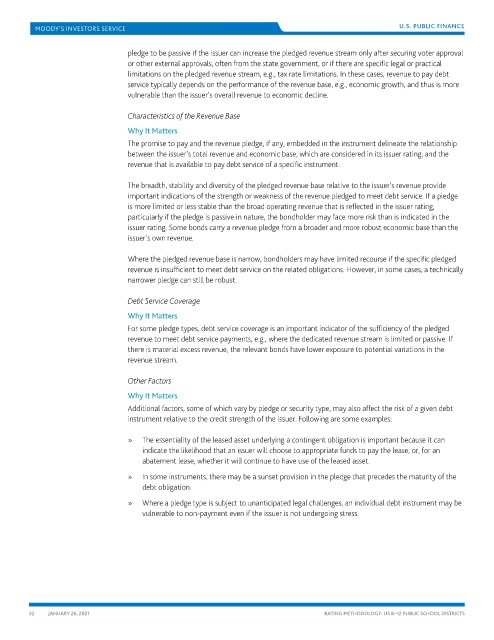Page 1670 - draft
P. 1670
U.S. PUBLIC FINANCE
pledge to be passive if the issuer can increase the pledged revenue stream only after securing voter approval
or other external approvals, often from the state government, or if there are specific legal or practical
limitations on the pledged revenue stream, e.g., tax rate limitations. In these cases, revenue to pay debt
service typically depends on the performance of the revenue base, e.g., economic growth, and thus is more
vulnerable than the issuer’s overall revenue to economic decline.
Characteristics of the Revenue Base
Why It Matters
The promise to pay and the revenue pledge, if any, embedded in the instrument delineate the relationship
between the issuer’s total revenue and economic base, which are considered in its issuer rating, and the
revenue that is available to pay debt service of a specific instrument.
The breadth, stability and diversity of the pledged revenue base relative to the issuer’s revenue provide
important indications of the strength or weakness of the revenue pledged to meet debt service. If a pledge
is more limited or less stable than the broad operating revenue that is reflected in the issuer rating,
particularly if the pledge is passive in nature, the bondholder may face more risk than is indicated in the
issuer rating. Some bonds carry a revenue pledge from a broader and more robust economic base than the
issuer’s own revenue.
Where the pledged revenue base is narrow, bondholders may have limited recourse if the specific pledged
revenue is insufficient to meet debt service on the related obligations. However, in some cases, a technically
narrower pledge can still be robust.
Debt Service Coverage
Why It Matters
For some pledge types, debt service coverage is an important indicator of the sufficiency of the pledged
revenue to meet debt service payments, e.g., where the dedicated revenue stream is limited or passive. If
there is material excess revenue, the relevant bonds have lower exposure to potential variations in the
revenue stream.
Other Factors
Why It Matters
Additional factors, some of which vary by pledge or security type, may also affect the risk of a given debt
instrument relative to the credit strength of the issuer. Following are some examples:
» The essentiality of the leased asset underlying a contingent obligation is important because it can
indicate the likelihood that an issuer will choose to appropriate funds to pay the lease, or, for an
abatement lease, whether it will continue to have use of the leased asset.
» In some instruments, there may be a sunset provision in the pledge that precedes the maturity of the
debt obligation.
» Where a pledge type is subject to unanticipated legal challenges, an individual debt instrument may be
vulnerable to non-payment even if the issuer is not undergoing stress.
32 JANUARY 26, 2021 RATING METHODOLOGY: US K–12 PUBLIC SCHOOL DISTRICTS

